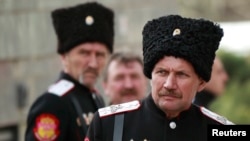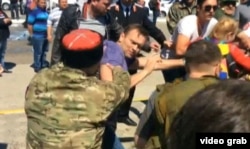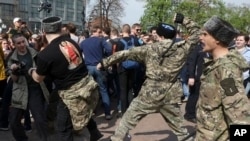Cossack patrols have done everything from securing courthouses to forcibly dispersing political protests in the Russian capital since President Vladimir Putin declared in 2012 that it is "the state's task to help the Cossacks in every way."
Descendants of fiercely religious and uber-patriotic groups that guarded the edges of Russia's frontiers for centuries during the tsarist era, their strong-arm tactics have drawn considerable criticism. Cossacks could be seen attacking opposition leader Aleksei Navalny and his supporters in the resort town of Anapa two years ago and physically assaulting members of punk-rock protest group Pussy Riot before the 2014 Sochi Winter Olympics.
Most recently, Cossacks were brandishing their signature horse whips against protesters at anti-Putin rallies in Moscow on May 5.
Denis Krivosheev, Amnesty International's deputy director for Eastern Europe and Central Asia, accused Moscow police of allowing "people in Cossack uniforms" to beat demonstrators.
"On what grounds people in ‘Cossack’ uniforms were allowed to use force remains a question," he said.
Reports suggest the Moscow Mayor's Office has paid some 5.33 million rubles ($85,000) over the past three years to train Cossacks to "ensure public safety" at events in the city, according to an online contract for public procurements.
The latest training session for some 100 Cossacks reportedly took place in March, according to the official website of the Moscow Mayor's Office, which includes photos from some of the training sessions.
Some of the Cossacks seen in the photos and video attacking demonstrators on May 5 were identified as members of the Central Cossack Troops (TsVK), an organization with ties to Russian security forces.
Russian media reported that Ivan Mironov -- the TsVK's ataman, or chief -- is a former Federal Security Service (FSB) officer, and TsVK members recently held meetings with national security officials to discuss security operations for soccer's World Cup, the world's largest sporting event.
The Cossacks will be used to "keep order" at some venues at the quadrennial football spectacle that will be held in 11 Russian cities from St. Petersburg to Sochi between June 14-July 15.
An estimated 300 Cossacks -- including 100 cavalrymen -- are due to work World Cup security at the five games being played in Rostov-on-Don alone, a local Cossack ataman, Mikhail Bespalov said on May 2.
Some of them have participated in several training sessions with security services to prepare for the games.
Bespalov said the Don Cossacks that will take part in providing security are "even starting to learn foreign languages," although he admitted they won't have time "to study five languages."
Nevertheless, he said the Cossacks will find a way to explain to people "where to go and how to behave."
Aleksandr Palatny, a Don Cossack director in the Rostov region, said the Cossacks would guard the areas around the stadium, near the airport, and in the fan zone in Theater Square, along with areas around central streets.
FIFA, football's world governing body, and several national soccer federations have been highly critical of Russian behavior at both domestic matches and international games in recent years, with violence by hooligans and humiliating racist chants and other incidents -- mainly against African players -- occurring regularly.
Russian fans were also involved in brutal riots with British fans and others during the 2016 European Cup in France, with supporters of Russia's national team being detained and some deported.
Russian ultra-fan organizations have recently physically threatened British and other national team supporters to be prepared for attacks during the World Cup in what many of the hooligans view as a type of competition to prove which country's ultras are tougher.
Persecuted and killed in the hundreds of thousands under communist rule, Cossacks have undergone a dramatic revival in the 18 years of Putin's political dominance -- with their numbers reportedly increasing by 400 percent from 2010 to 2016 to some 180,000 within Russia.
Their ethnic origins are still a matter of dispute, with competing theories assigning varying degrees of descent from Slavic and Turkic tribes. But Cossacks emerged as an identifiable group in 15th-century historical writings about peoples inhabiting what is now southern Russia and southeastern Ukraine.
Modern-day Cossack communities are frequently multiethnic and ardently Russian Orthodox, and can be found throughout Russia and in parts of Ukraine.
While mostly regarded as well-integrated into Russian life, Cossacks often live in self-governing communities and frequently have strong ties to official military and paramilitary organizations.
They also tend to be highly organized and draw new adherents who are often attracted to an idyllic version of the Cossack lifestyle.











